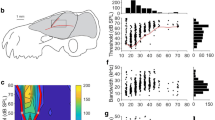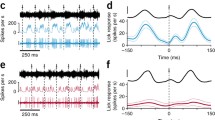Summary
-
1.
Acoustically evoked responses of 284 neurons isolated from the cerebellar vermis, hemispheres and paraflocculus of Rhinolophus pearsonic chinesis were studied under free field acoustic stimulation conditions.
-
2.
The BFs of these cerebellar auditory neurons ranged from 24 to 76 kHz but they mostly fall either between 48 and 64 kHz or between 65 and 76 kHz (Fig. 1). However, the BF distribution varies among vermal, hemispheric and parafloccular neurons (Fig. 2).
-
3.
Threshold curves of cerebellar neurons are generally broad but those tuned to the frequency of the predominant CF component are extremely narrow (Fig. 3).
-
4.
Response latencies of cerebellar neurons ranged from 2 to 48 ms suggesting multiple auditory cerebellar pathways. The latency distribution also varies among vermal, hemispheric and parafloccular neurons (Fig. 4, Table 1).
-
5.
Although both the vermis and hemispheres contain a disproportionate number of 65–74 kHz neurons, the response latencies of those neurons isolated from the vermis are scattered over a wide range of 2.2–28 ms while those neurons isolated from the hemispheres are generally stabilized between 5 and 12 ms (Fig. 5).
-
6.
Electrical stimulation of the auditory cortex evokes discharges from a recorded cerebellar auditory neuron (Fig. 6). Cortical stimulation also facilitates the response of an acoustically evoked cerebellar neuron by increasing its number of impulses (Fig. 7). The degree of facilitation is dependent upon the amplitude of the acoustic stimulus (Fig. 8).
-
7.
For a given electrical and acoustic stimulation condition, the facilitative latency and the degree of facilitation varied with the interstimulus interval. Among 23 neurons studied, most of them (19 neurons, 82.6%) had a maximal facilitative latency between 2 and 10 ms (Fig. 9B).
-
8.
By examining the difference in the facilitative effect in each isolated cerebellar auditory neuron before and after a topical application of local anesthetic, procaine, onto the point of electrical stimulation in the auditory cortex, we found that the facilitative pathways to vermal and hemispheric neurons may be different from the pathway to parafloccular neurons (Figs. 10, 11).
-
9.
Possible auditory pathways to different parts of the cerebellum are discussed in relation to the wide range of recorded response latencies.
-
10.
The facilitative influence of the auditory cortex on the cerebellar auditory neurons is assumed to enhance the cerebellar role in acoustic motor orientation.
Similar content being viewed by others
Abbreviations
- BF :
-
best frequency
- MT :
-
minimum threshold
- PST :
-
post-stimulus-time
References
Aitkin LM, Boyd J (1975) Responses of single units in cerebellar vermis of the cat to monaural and binaural stimuli. J Neurophysiol 38:418–429
Altman JA, Bechterev NN, Radinova EA, Shmigidina GN, Syka J (1976) Electrical responses of the auditory area of the cerebellar cortex to acoustic stimulation. Exp Brain Res 26:285–298
Azizi SA, Burne RA, Woodward DJ (1985) The auditory corticopontocerebellar projection in the rat: input to the paraflocculus and midvermis. An anatomical and physiological study. Exp Brain Res 59:36–49
Azizi SA, Mihailoff GA, Burne RA, Woodward DJ (1981) The pontocerebellar system in the rat: an HRP study I. Posterior vermis. J Comp Neurol 197:543–558
Brodal P (1972) The corticopontine projection in the cat. The projection from the auditory cortex. Arch Ital Biol 110:119–144
Brodal P (1982) The cerebropontocerebellar pathway: salient features of its organization. Exp Brain Res, Suppl 6:108–132
Burne RA, Eriksson MA, Saint-Cyr JA, Woodward DJ (1978) The organization of the pontine projection to lateral cerebellar areas in the rat: dual zones in the pons. Brain Res 139:340–347
Diamond IT, Jones EG, Powell TPS (1969) The projection of the auditory cortex upon the diencephalon and brain stem in the cat. Brain Res 15:305–340
Freeman JA (1970) Responses of cat cerebellar Purkinje cells to convergent inputs from cerebral cortex and peripheral sensory systems. J Neurophysiol 33:697–712
Gacek RR (1973) A cerebellocochlear nucleus pathway in the cat. Exptl Neurol 40:101–112
Griffin DR (1958) Listening in the dark. Yale University Press, New Haven, Connecticut (Reprinted by Dover Publication, New York 1974)
Grinnell AD (1973) Neural processing mechanisms in echolocating bats correlated with differences in emitted sounds. J Acoust Soc Am 54:147–156
Henson OW, Eager RP, Henson AM (1968) Tecto-cerebellar projections in the bat, Tadarida brasiliensis murina. Anat Rec 160:473–474
Highstein S, Coleman PD (1968) Responses of the cerebellar vermis to binaural auditory stimulation. Brain Res 10:470–473
Horikawa J, Suga N (1986) Biosonar signals and cerebellar auditory neurons of the mustached bat. J Neurophysiol 55:1247–1267
Huang CM, Liu G, Huang R (1982) Projections from the cochlear nucleus to the cerebellum. Brain Res 244:1–8
Ito M (1984) The cerebellum and neural control. Raven Press, New York
Jastreboff PJ, Tarnecki R (1975a) Response of cat cerebellar vermis induced by sound. I. Influence of drugs on responses of single units. Acta Neurobiol Exp 35:209–216
Jastreboff PJ, (1975 b) Response of cerebellar vermis induced by sound. II. The role of the mossy and climbing fibers in acoustic transmission to the cerebellar cortex and influence of stimuli parameters. Acta Neurobiol Exp 35:217–225
Jen PH-S (1982) Echolocation in the bat: Obstacle avoidance by the bat and signal coding in the bat's cerebellum. Proc Natl Sci Coun (China) 6:71–80
Jen PH-S, Schlegel PA (1980) Neurons in the cerebellum of echolocating bats respond to acoustic signals. Brain Res 196:502–507
Jen PH-S, Vater M, Harnischfeger G, Rübsamen R (1981) Mapping of the auditory area in the cerebellar vermis and hemispheres of the little brown bat, Myotis lucifugus. Brain Res 219:156–161
Jen PHS-S, Sun X, Kamada T (1982) Responses of cerebellar neurons of the CF-FM bat, Pteronotus parnellii to acoustic stimuli. Brain Res 252:167–171
Jen PH-S, Kamada T, Sun XD, Schlegel P, Vater M, Harnischfeger G, Rübsamen R (1984) Comparative auditory physiology of cerebellar neurons of FM bats and CF-FM bats. Chinese J Physiol 27:1–26
Kawamura K (1975) The pontine projection from the inferior colliculus in the cat. An experimental anatomical study. Brain Res 95:309–322
Kawamura K, Brodal A (1973) The tectopontine projection in the cat: an experimental anatomical study with comments on pathways for teleceptive impulses to the cerebellum. J Comp Neurol 149:371–390
Kawamura K, Chiba M (1979) Cortical neurons projecting to the pontine nuclei in the cat. Exp Brain Res 35:269–285
Larson CR, Sutton D, Lindeman RC (1978) Cerebellar regulation of phonation in rhesus monkey (Macaca mulatta). Exp Brain Res 33:1–18
Mihailoff GA, Burne RA, Azizi SA, Norelli G, Woodward DJ (1981) The pontocerebellar system in the rat: an HRP study. II. Hemispheral components. J Comp Neurol 197:559–577
Misrahy GA, Spradley JF, Beran AV, Garwood VP (1961) Acoustic cerebellar pathways in cats. J Neurophysiol 24:159–166
Mitra J, Snider RS (1969) Cerebellar modification of unitary discharges in auditory system. Exp Neurol 23:341–352
Mortimer JA (1975) Cerebellar responses to teleceptive stimuli in alert monkeys. Brain Res 83:369–390
Niemer WR, Cheung SK (1949) The ascending auditory system: a study of retrograde degeneration. Anat Rec 103:490
Olsen JF (1982) The tonotopic organization of the auditory geniculocortical and corticopontine projections in a CF-FM bat. Soc Neurosci Abstr 8:349
Payne JN (1983) Axonal branching in the projections from precerebellar nuclei to the lobulus simplex of the rat's cerebellum investigated by retrograde fluorescent double labeling. J Comp Neurol 213:233–240
Powell E, Hatton JB (1969) Projections of the inferior colliculus in the cat. J Comp Neurol 136:183–192
Schnitzler HU (1968) Die Ultraschall-Ortungslaute der Hufeisen-Fledermäuse (Chiroptera-Rhinolophidae) in verschiedenen Orientierungssituationen. Z Vergl Physiol 57:376–408
Shofer RJ, Nahvi MJ (1969) Firing patterns induced by sound in single units of the cerebellar cortex. Exp Brain Res 8:327–345
Shute CCD, Lewis PR (1965) Cholinesterase containing pathways of the hindbrain:afferent cerebellar and centrifugal cochlear fibers. Nature (Lond) 205:242–246
Snider RS, Eldred E (1952) Cerebro-cerebellar relationships in the monkey. J Neurophysiol 15:27–40
Snider RS, Sato K, Mizuno S (1964) Cerebellar influences on evoked cerebral responses. J Neurol Sci 1:325–339
Snider RS, Stowell A (1944) Receiving areas of the tactile, auditory and visual systems in the cerebellum. J Neurophysiol 7:331–358
Sun XD, Jen PH-S (1989) Electrical stimulation of bat superior colliculus influences responses of inferior collicular neurons to acoustic stimuli. Brain Res 497:214–222
Sun XD, Jen PH-S, Sun DX, Zhang SF (1989) Corticofugal influences on the responses of bat inferior collicular neurons to sound stimulation. Brain Res 495:1–8
Sun XD, Jen PH-S, Kamada T (1983) Mapping of the auditory area in the cerebellar vermis and hemispheres of the mustache bat, Pteronotus parnellii parnellii. Brain Res 271:162–165
Sun XD, Jen PH-S, Zhang WP (1987) Auditory spatial response areas of single neurons and space representation in the cerebellum of echolocating bats. Brain Res 414:314–322
Teramoto S, Snider RS (1966) Modification of auditory responses by cerebellar stimulation. Exp Neurol 16:191–200
Velluti R, Crispino L (1979) Cerebellar actions on cochlear microphonics and on auditory nerve action potentials. Brain Res Bull 4:621–624
Watson PJ (1978) Nonmotor functions of the cerebellum. Psychol Bull 85:944–967
Wolfe JW (1972) Responses of the cerebellar auditory area to pure tone stimuli. Exp Neurol 36:295–309
Wolfe JW, Kos CM (1975) Cerebellar inhibition of auditory function. Trans Am Acad Ophthalmol Otolaryngol 80:314–318
Zhang SQ, Sun XD, Jen PH-S (1990) Auditory projections to the cerebellum of echolocating bats. Acta Anatomica Sinica (in press)
Author information
Authors and Affiliations
Rights and permissions
About this article
Cite this article
Sun, D., Sun, X. & Jen, P.HS. The influence of the auditory cortex on acoustically evoked cerebellar responses in the CF-FM bat, Rhinolophus pearsonic chinesis . J Comp Physiol A 166, 477–487 (1990). https://doi.org/10.1007/BF00192018
Accepted:
Issue Date:
DOI: https://doi.org/10.1007/BF00192018




